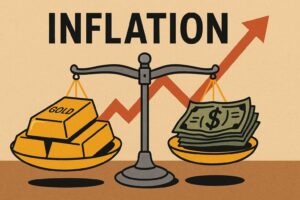Daily News Nuggets | Today’s top stories for gold and silver investors
November 18th, 2025
Jobless Claims Data Trickles Out After Shutdown
After weeks of radio silence due to the government shutdown, we’re finally getting labor market data — though it’s a month old. Initial jobless claims totaled 232,000 for the week ending October 18, released Tuesday after a delayed schedule. The number shows layoffs remain low, but hiring has clearly slowed. Continuing claims rose to 1.96 million, suggesting unemployed workers are having trouble landing new positions.
The shutdown created what analysts are calling a “data black hole,” making it hard to gauge real-time economic momentum. With several weeks of data still missing, markets are treating any new information with caution. The next jobless claims report lands Thursday, and if weakness continues, it could strengthen the case for a December Fed rate cut. Until then, the fog of uncertainty persists.
Consumer Sentiment Crashes to Near-Record Low
The longest government shutdown in U.S. history is taking a psychological toll. Consumer sentiment plunged to 50.3 in November — the lowest reading since June 2022 and just above the all-time low of 50 recorded during that period. The University of Michigan survey showed widespread pessimism across all income levels and political affiliations, with fears mounting about the shutdown’s economic fallout. Personal finance outlooks dropped 17% and business condition expectations fell 11%.
The one bright spot? Wealthy investors with large stock holdings actually saw sentiment rise 11%, buoyed by market gains. That divergence underscores the growing wealth gap and uneven economic recovery. And it’s not just sentiment that’s suffering — household finances are cracking under the pressure…
Credit Card Delinquencies Hit 15-Year Highs
American households are drowning in debt, and the numbers are getting harder to ignore. Credit card delinquencies just hit their highest level since 2010, with more than 11% of balances now 90+ days overdue. Total U.S. household debt has climbed to $18.6 trillion, with credit card balances alone topping $1.2 trillion.
The pain is hitting hardest in lower-income communities, where delinquency rates have surged 63% since 2021. Even high-income ZIP codes saw rates jump 73%. Despite a relatively strong labor market, Americans are struggling to keep up with payments—a sign that inflation and high interest rates are biting deeper than the headline employment data suggests. For investors watching economic stress build, gold’s role as a financial safe haven becomes more relevant with each uptick in consumer distress.
S&P 500 Eyes Longest Losing Streak Since August
Wall Street’s six-month rally is showing cracks. The S&P 500 is on track for its fourth consecutive day of losses — the longest slide since late August — as investors reassess stretched valuations in tech and AI stocks. A $1.2 trillion crypto selloff, with Bitcoin briefly dipping below $90,000, added to the risk-off mood. The S&P now trades at 22 times forward earnings, well above its 10-year average of 19.
Concerns about the government shutdown’s economic impact and fading expectations for near-term Fed rate cuts are weighing on sentiment. The tech-heavy Nasdaq has fallen more than 5% from its recent high, with AI darlings like Nvidia facing questions about whether their valuations can hold. Friday saw dip-buyers step in, helping the S&P recover from deeper losses, but the unease lingers. For now, volatility is back on the menu.
The Rich Are “Renting” Out Their Gold Bars
Here’s a new twist on gold investing: wealthy investors are now leasing their idle bullion to refiners and jewelers in exchange for yield. As gold prices hover near historic highs, this practice — once limited to central banks and major institutions — is going mainstream through platforms like SafeGold, Monetary Metals, and Alpine Gold Exchange. The appeal is straightforward: earn 2-4% annual returns paid in gold while maintaining ownership of your bars.
Why the surge? Record gold prices have made it expensive for jewelers and fabricators to finance inventory through traditional loans, so they’re turning to gold leases instead. The platforms use insurance, audits, and RFID tracking to minimize fraud risk, though default remains the biggest concern. For investors who already plan to hold gold long-term, it’s a way to generate income from an asset that traditionally produces none.
Investing in Physical Metals Made Easy
Open an Account






